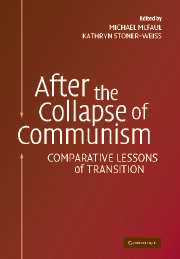Book contents
- Frontmatter
- Contents
- Contributors
- Introduction: The Evolving Social Science of Postcommunism
- 1 The Triumph of Nation-States: Lessons from the Collapse of the Soviet Union, Yugoslavia, and Czechoslovakia
- 2 The Fourth Wave of Democracy and Dictatorship: Noncooperative Transitions in the Postcommunist World
- 3 Circumstances versus Policy Choices: Why Has the Economic Performance of the Soviet Successor States Been So Poor?
- 4 Whither the Central State? The Regional Sources of Russia's Stalled Reforms
- 5 Parties, Citizens, and the Prospects for Democratic Consolidation in Russia
- 6 Comparative Democratization: Lessons from Russia and the Postcommunist World
- 7 Russians as Joiners: Realist and Liberal Conceptions of Postcommunist Europe
- Index
1 - The Triumph of Nation-States: Lessons from the Collapse of the Soviet Union, Yugoslavia, and Czechoslovakia
Published online by Cambridge University Press: 07 September 2011
- Frontmatter
- Contents
- Contributors
- Introduction: The Evolving Social Science of Postcommunism
- 1 The Triumph of Nation-States: Lessons from the Collapse of the Soviet Union, Yugoslavia, and Czechoslovakia
- 2 The Fourth Wave of Democracy and Dictatorship: Noncooperative Transitions in the Postcommunist World
- 3 Circumstances versus Policy Choices: Why Has the Economic Performance of the Soviet Successor States Been So Poor?
- 4 Whither the Central State? The Regional Sources of Russia's Stalled Reforms
- 5 Parties, Citizens, and the Prospects for Democratic Consolidation in Russia
- 6 Comparative Democratization: Lessons from Russia and the Postcommunist World
- 7 Russians as Joiners: Realist and Liberal Conceptions of Postcommunist Europe
- Index
Summary
Today, twenty-eight nation-states founded on the principle that a nation has a right to a state of its own stand where, a little over a decade ago, nine states had vowed to replace nations with socialist internationalism. Fifteen Soviet, five Yugoslav, and two Czechoslovak successor states stand where previously there were three multinational unions. This postcommunist transition represented the second most intense burst of new states to enter the international system since 1815. This is curious because it took place at a time when nations and states, we are told, are under assault as never before from global forces. This development begs the question that I will address in this chapter – what accounts for the triumph of these nationstate projects rather than others?
The nation-state has two faces – as a community and as an institution – and social scientists have used two different approaches to explain its triumph. Students of nationalism emphasize the element of national community and commonly attribute the triumph of nation-state projects to the demand by peoples for states of their own. Alternatively, many students of international relations have stressed the institutional development of the state and attribute the triumph of the nation-state to international selection mechanisms that favor this institutional form over its multinational competitors: nation-states trump the multinational alternatives by their military prowess, economic efficiency, or international acceptance. Yet neither approach offers an entirely satisfactory account of the postcommunist transformation.
- Type
- Chapter
- Information
- After the Collapse of CommunismComparative Lessons of Transition, pp. 21 - 57Publisher: Cambridge University PressPrint publication year: 2004
- 4
- Cited by



